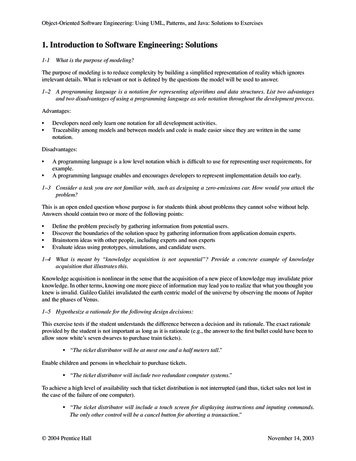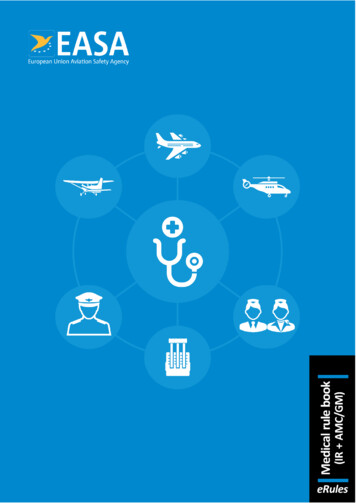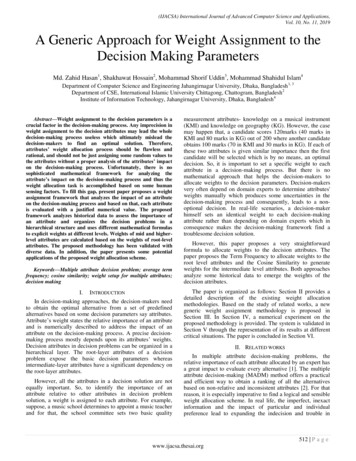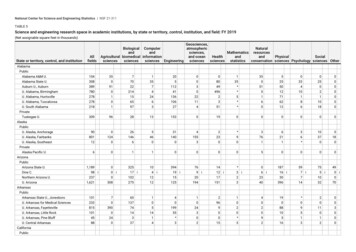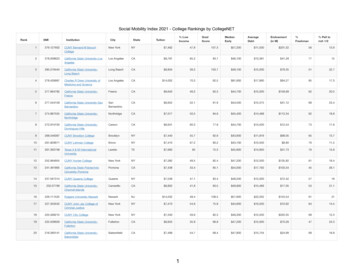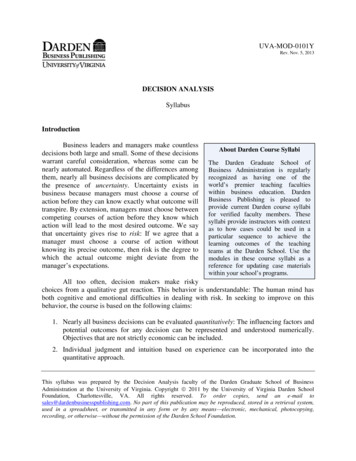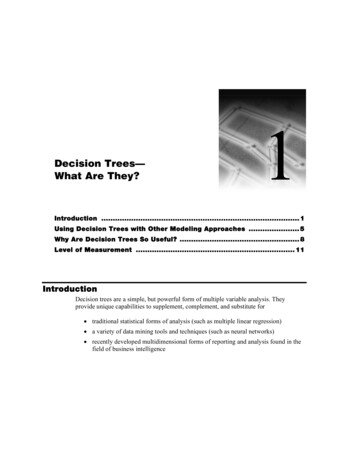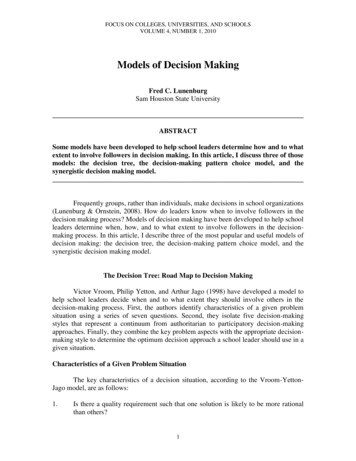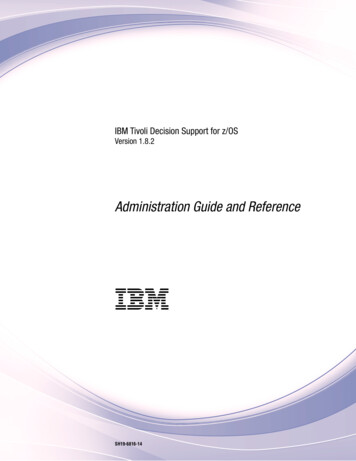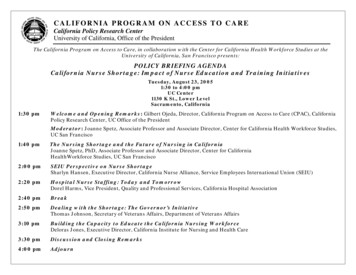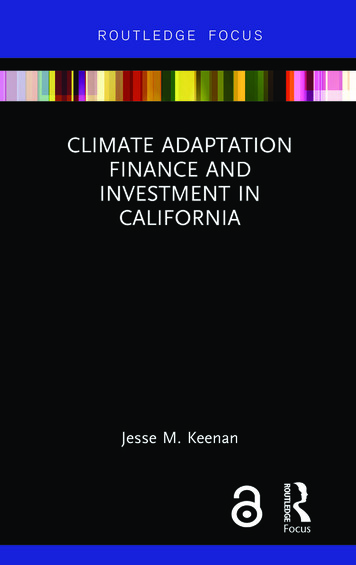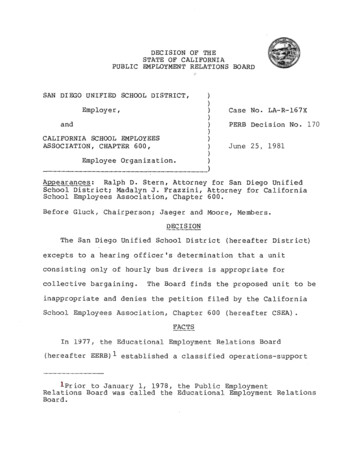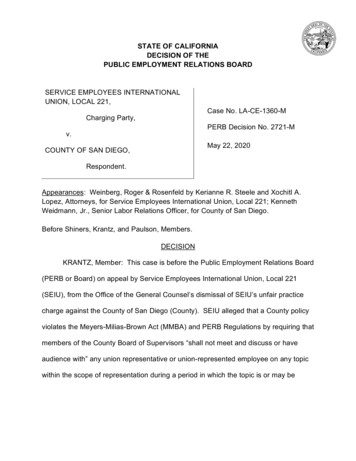
Transcription
STATE OF CALIFORNIADECISION OF THEPUBLIC EMPLOYMENT RELATIONS BOARDSERVICE EMPLOYEES INTERNATIONALUNION, LOCAL 221,Charging Party,Case No. LA-CE-1360-MPERB Decision No. 2721-Mv.May 22, 2020COUNTY OF SAN DIEGO,Respondent.Appearances: Weinberg, Roger & Rosenfeld by Kerianne R. Steele and Xochitl A.Lopez, Attorneys, for Service Employees International Union, Local 221; KennethWeidmann, Jr., Senior Labor Relations Officer, for County of San Diego.Before Shiners, Krantz, and Paulson, Members.DECISIONKRANTZ, Member: This case is before the Public Employment Relations Board(PERB or Board) on appeal by Service Employees International Union, Local 221(SEIU), from the Office of the General Counsel’s dismissal of SEIU’s unfair practicecharge against the County of San Diego (County). SEIU alleged that a County policyviolates the Meyers-Milias-Brown Act (MMBA) and PERB Regulations by requiring thatmembers of the County Board of Supervisors “shall not meet and discuss or haveaudience with” any union representative or union-represented employee on any topicwithin the scope of representation during a period in which the topic is or may be
subject to negotiation or consultation. 1 The Office of the General Counsel (OGC)found SEIU’s charge untimely, and this appeal ensued.In resolving an appeal of a dismissal, we review OGC’s decision de novo.(Lake Elsinore Unified School District (2018) PERB Decision No. 2548, p. 6, fn. 5(Lake Elsinore); City of San Jose (2013) PERB Decision No. 2341-M, p. 47.) At thisstage of the case, “the charging party’s burden is not to produce evidence, but merelyto allege facts that, if proven true in a subsequent hearing, would state a prima facieviolation.” (County of Santa Clara (2013) PERB Decision No. 2321-M, p. 13, fn. 8.)Accordingly, we assume the charging party’s factual allegations are true, and we viewthem in the light most favorable to the charging party. (Cabrillo Community CollegeDistrict (2015) PERB Decision No. 2453, p. 8 (Cabrillo I); Cabrillo Community CollegeDistrict (2019) PERB Decision No. 2622, p. 4 (Cabrillo II).) We do not rely on therespondent’s responses if they explicitly or implicitly create a factual conflict withcharging party’s factual allegations, even if the respondent’s contrary responses arestated more persuasively or appear as though they may be backed up by moresupporting evidence, when compared to charging party’s allegations. (Cabrillo I,supra, PERB Decision No. 2453, p. 8; Salinas Valley Memorial Healthcare System(2012) PERB Decision No. 2298-M, p. 13.) 21 The MMBA is codified at Government Code section 3500 et seq. Unlessotherwise specified, all statutory references herein are to the Government Code.PERB Regulations are codified at California Code of Regulations, title 8, section 31001et seq.However, a charging party cannot state a prima facie case merely by makinglegal allegations. (Lake Elsinore, supra, PERB Decision No. 2548, p. 18.)22
Thus, in this procedural posture we generally do not resolve conflictingallegations, make conclusive factual findings, or judge the merits of the dispute.(Cabrillo II, supra, PERB Decision No. 2622, pp. 4-5; County of Santa Clara, supra,PERB Decision No. 2321-M, p. 12.) Nonetheless, it is appropriate to dismiss analleged violation without issuing a complaint if the parties’ filings disclose undisputedfacts sufficient to defeat the claim. (Cabrillo I, supra, PERB Decision No. 2453, p. 9.)When the sufficiency of a charge turns on interpreting a statute, contract, oremployer rule or policy, the Board must accept the plain meaning of the language atissue if it is “clear and unambiguous on its face.” (County of Monterey (2018) PERBDecision No. 2579-M, p. 8.) If the language is ambiguous, “the parties must beafforded the opportunity to offer evidence in support of their respective interpretations ata formal hearing.” (Ibid.) At the charge investigation stage, “the appropriate question isnot which of two competing interpretations . . . is the more plausible, but whether thelanguage in dispute is reasonably susceptible to the charging party’s interpretationand whether that interpretation supports a viable, i.e., non-frivolous, theory of liabilityunder the applicable PERB-administered statute.” (Ibid.)The Board has reviewed the entire record, including the initial unfair practicecharge, the first amended charge, the second amended charge, the County’s positionstatements responding to each charge, OGC’s warning and dismissal letters, SEIU’sappeal, and the County’s response. Based on this review, we grant SEIU’s appeal inpart, and we remand to OGC to issue a complaint consistent with this decision. Wefirst recount the facts we must assume are true at this stage, and we then applyrelevant law to those assumed facts.3
BACKGROUNDThe County is a public agency within the meaning of MMBA section 3501,subdivision (c). SEIU, a recognized employee organization within the meaning ofMMBA section 3501, subdivision (b), exclusively represents County employees in tenbargaining units. SEIU and the County are parties to four Memoranda of Agreement(MOAs) establishing terms and conditions of employment for the ten SEIUrepresented bargaining units. Each of the MOAs is effective from October 13, 2017 toJune 23, 2022.In 1977, the County’s Board of Supervisors adopted a “Policy on MattersSubject to Meet and Confer," referring to it at that time as Policy 13. In 1982, theBoard of Supervisors reviewed and reapproved the policy with several non-substantivewording changes, resulting in the following updated policy:“It is the policy of the Board of Supervisors that: Membersof this Board outside of meetings of this Board shall notmeet and discuss or have audience with any employee orany employee organization or representative thereof on anymatter within the scope of representation or consultationduring the period when such matters are, should be, or maybe, the subject of consultations, or meeting and conferringbetween the County negotiator and an employee or anemployee organization. It is appropriate in suchcircumstances for the person seeking such audience to bereferred to the County negotiator.”As part of reapproving the policy in 1982, the Board of Supervisors renumberedit as Policy A-93. Thereafter, the Board of Supervisors reviewed and reapproved4
Policy A-93, without change, in 1988, 1994, 2006, 2008, and 2011, as well as mostrecently in the fall of 2018. 3The Board of Supervisors engaged in its fall 2018 review as part of theCounty’s Sunset Review Process, which requires that most County policies, codes,and ordinances sunset after seven years, and that the Board of Supervisors mustdetermine in advance of such sunset date what action it should take relative to theexpiring policy. 4 When the Board of Supervisors reapproved Policy A-93 in 2011, itset a sunset date of December 31, 2018. Absent reapproval prior to this sunset date,Policy A-93 would have no longer been in effect. Pursuant to the Sunset ReviewProcess, the Board of Supervisors reviewed Policy A-93 in the fall of 2018, in order todecide what action it should take relative to the expiring policy. The Board chose toreapprove it without change and established a new sunset date in 2025.DISCUSSIONSEIU’s allegations presented four different claims: interference, discrimination,maintenance of an unreasonable local rule, and unilateral change. However, onappeal of OGC’s dismissal, SEIU chose not to pursue its unilateral change theory.3 Based on available information at this stage, it appears that the Board ofSupervisors reviewed Policy A-93 on October 30, 2018 and took final action toreapprove the policy on November 13, 2018. We use the term “reapprove” becausethe County used that term in its position statements and its opposition to SEIU’sappeal, and because the term appears to describe accurately what occurred.We take administrative notice of the County’s current Sunset Review Process(Board of Supervisors Policy A-76), which was last reapproved in 2016 and is itself setto sunset in 2023.45
We therefore do not consider it, and we leave undisturbed OGC’s dismissal of SEIU’sunilateral change allegation.I.The Continuing Violation Doctrine and the New Wrongful Act DoctrinePERB generally may not issue a complaint based upon an alleged unfairpractice that occurred more than six months before the charge was filed. (CoachellaValley Mosquito & Vector Control Dist. v. California Public Employment Relations Bd.(2005) 35 Cal.4th 1072, 1091.) The six-month statute of limitations period begins torun when the charging party knows, or should have known, of the conduct underlyingthe charge. (Gavilan Joint Community College District (1996) PERB DecisionNo. 1177, p. 4.) However, in San Dieguito Union High School District (1982) PERBDecision No. 194 (San Dieguito), the Board “articulated three distinct exceptions to thesix-month rule: ‘the charge may still be considered to be timely filed if the allegedviolation is a continuing one, if the violation has been revived by subsequent unlawfulconduct within the six-month period, or if the limitation period was tolled.’” (City &County of San Francisco (2017) PERB Decision No. 2536, p. 15, fn. 14, quoting SanDieguito, supra, PERB Decision No. 194, p. 5.)In San Dieguito, a union alleged that a school district made an unlawfulunilateral change when it implemented a new policy requiring teachers to sign outwhen leaving campus during their preparation period. (San Dieguito, supra, PERBDecision No. 194, pp. 2-3.) Although the union did not file a charge until two yearsafter the district first implemented the sign out policy, the union claimed that its chargewas timely because the district continued to enforce the policy after implementing it,including in the six months before the union filed its charge. (Id. at pp. 2, 5-6.) The6
Board, relying on decisions of the National Labor Relations Board, held that in aunilateral change case, continuing enforcement of a unilaterally implemented policy isinsufficient to create an exception to the statute of limitations. (Id. at pp. 5-10.) TheBoard next addressed the new wrongful act exception and found no conduct occurringwithin the limitations period (such as reimplementation, a further change, or a failure tobargain) that would revive the unilateral change claim for statute of limitationspurposes. (Id. at p. 10.) In unilateral change charges, then, the new wrongful actdoctrine can apply if there are sufficient facts to support the exception, but thecontinuing violation doctrine does not apply. (See, e.g., City of Livermore (2014)PERB Decision No. 2396-M, p. 6 [“Under the applicable legal standard in unilateralchange cases, the statute of limitations begins to run on the date that the chargingparty has actual or constructive notice of the respondent’s clear intent to implement aunilateral change in policy, provided that nothing subsequent to that date evinces awavering of that intent.”].)In decisions such as San Dieguito, supra, PERB Decision No. 194, p. 5, andCity & County of San Francisco, supra, PERB Decision No. 2536, p. 15, fn. 14, theBoard was clear that the continuing violation doctrine and the new wrongful actdoctrine are separate exceptions to the statute of limitations. In other decisions,however, the Board seemingly merged the continuing violation doctrine and the newwrongful act doctrine, declaring that the Board may find a continuing violation only ifthe respondent engaged in a new wrongful act within the limitations period. Forinstance, in El Dorado Union High School District (1984) PERB Decision No. 382 (ElDorado), the Board stated:7
“a continuing violation would only be found where activeconduct or grievances occurred within the limitations periodthat independently constituted an unfair practice. [Citation.]However, a continuing violation would not be found wherethe employer’s conduct during the limitations periodconstituted an unfair practice only by its relation to theoriginal offense. [Citation.] Where the underlying theory ofthe charge is an alleged unilateral change occurring outsidethe limitations period, the employer must engage in conductduring the limitations period ‘such as reimplementation orsubsequent refusals to negotiate . . . [which] revive[s] theviability of the unfair practice.’ [Citation.]”(Id. at pp. 4-5.) Because El Dorado involved an alleged unilateral change, the Boardshould have focused, and in practice did focus, on the new wrongful act doctrine. TheBoard properly found that the district implemented the policy in question more than sixmonths before the union filed its charge, and the district’s conduct within thelimitations period—defending its policy in response to the union’s protest—did nothave sufficient independent significance to constitute a new wrongful act. (Id. atpp. 5-6.) Accordingly, the Board’s improper blurring of distinct exceptions did notprevent the Board from reaching the correct result in a unilateral change case.In analyzing other types of charges, either the continuing violation doctrine orthe new wrongful act doctrine may apply, and blurring the line between the twodoctrines may lead to incorrect results. For instance, in Fresno County Office ofEducation (1993) PERB Decision No. 978 (Fresno), a union asserted that an employerinterfered with protected rights by refusing to recognize the union’s designated siterepresentative. Although the union filed its charge more than six months after theemployer refused to recognize the site representative, the union correctly noted thatthe interference was continuing. (Id., adopting partial dismissal letter at pp. 1-2.)8
Nonetheless, the Board adopted a board agent’s decision to dismiss the charge,relying on El Dorado’s mistaken statement that a charging party cannot establish acontinuing violation without showing a new wrongful act within the limitations period.(Id., adopting partial dismissal letter at p. 2.) However, to fall within the continuingviolation exception, the charging party did not need to allege that the employerrestated its position during the limitations period, nor that such a restatement hadsufficient independent significance to constitute a new wrongful act, as no such newact is necessary for the continuing violation doctrine to apply. The critical point wasthat the employer allegedly continued to interfere with the union’s rights on an ongoingbasis by refusing to recognize its authorized site representative. Because the Boardfailed to recognize that the continuing violation exception applied, we overruleFresno’s treatment of the union’s interference allegation.We turn now to how these doctrines apply in the broad category of cases intowhich the instant matter falls: interference or discrimination charges challenging anemployer policy or rule. 55 Section I of our discussion, ante, applies to any type of unfair practice charge,as the continuing violation doctrine and new wrongful act doctrine are always distinctexceptions requiring separate analysis. In contrast, Sections II and III, post, pertainonly to interference or discrimination charges challenging an employer policy or rule.In those sections, we do not consider the exceptions’ application to other types ofcharges. (See, e.g., San Mateo County Community College District (1993) PERBDecision No. 1030, p. 12, fn. 7 [bad faith bargaining allegations found to constitutecontinuing violation]; cf. Anaheim Union High School District (2015) PERB DecisionNo. 2434, adopting proposed decision at p. 58 [considering bargaining conductoutside the statute of limitations because “[a]rtificially removing from consideration anybargaining conduct older than six months for any purpose is antithetical to the ‘totalityof the bargaining conduct’ analysis and would, in this dispute, exclude almost half ofthe parties’ bargaining conduct”].)9
IIThe Board’s Application of the Continuing Violation Doctrine and New WrongfulAct Doctrine to Employer Rules or Policies That Allegedly Interfere with orDiscriminate Against Protected RightsIn analyzing employer policies and rules, the Board has long recognized thatinterference with protected rights may continue indefinitely after an employer firstadopts a policy, in which case the statute of limitations for an interference claim doesnot lapse even though the limitations period for a unilateral change claim lapses sixmonths after policy adoption. For instance, Long Beach Unified School District (1987)PERB Decision No. 608 (Long Beach) addressed an employer policy limiting the timesand locations that union representatives were permitted to meet with employees. (Id.at pp. 9-10.) The Board held that the specific date the employer adopted or revisedthe rule or policy “has no legal significance” because the rule’s continued existencequalifies as a continuing violation. (Id. at p. 12.) In so holding, the Board noted thatthe union need not show that it attempted to violate the policy within the limitationsperiod for its charge to be timely under the continuing violation doctrine. (Ibid.)The Board has followed the same principles in resolving allegations that anemployer policy discriminates against protected activities. For instance, in State ofCalifornia (Departments of Personnel Administration, Banking, Transportation, WaterResources, and Board of Equalization) (1998) PERB Decision No. 1279-S (State ofCalifornia), the Board held that a union timely challenged a policy prohibiting use ofstate equipment for union purposes, even though the employer had implemented thepolicy years earlier, because “the challenged discriminatory application of the Statepolicy remained in effect during the period six months prior to the filing of the charge.”(Id., adopting proposed decision at p. 32.) The Board also correctly declined to apply10
the continuing violation doctrine to the union’s separate unilateral change allegation.(Id., adopting proposed decision at p. 33.) 6 And in State of California (Department ofCorrections) (1999) PERB Decision No. 1339-S, the Board found timely an allegationthat the employer discriminatorily refused to allow the union to use meeting roomsbecause “the charge clearly alleges unlawful conduct occurring within six months priorto the date of the charge.” (Id. at pp. 8-9 & fn. 5.)This area of law became more confusing, however, when the Legislature vestedPERB with jurisdiction over the MMBA in 2000 and the Board began to addresschallenges to local agencies’ employer-employee relations rules. In County of Orange(2006) PERB Decision No. 1868-M (Orange), the Board declined to extend LongBeach to facial challenges to local employer-employee relations rules, holding that forsuch an allegation to be timely, an employer must actually have applied a local rule tothe charging party within the limitations period. (Id. at pp. 5-7.) In County of Riverside(2011) PERB Decision No. 2176-M, the Board found no continuing violation where theemployer had applied the challenged local rule to deny the union’s request forregistration more than six months before the charge was filed. (Id. at pp. 6-10.)The Board then corrected its course by overruling Orange in part, and holdingthat the continuing violation doctrine applies to challenges to local rules other thanthose challenges premised on an employer’s alleged failure to meet and confer ormeet and consult. (City & County of San Francisco, supra, PERB Decision No. 2536M, 14-15 & fn. 12.) This principle makes “particular sense in the realm of labor6 As in El Dorado, the Board’s description of the legal standard conflated thecontinuing violation and new wrongful act exceptions (State of California, supra, PERBDecision No. 1279, p. 2), but the Board reached the correct result under each.11
relations, because, as a matter of labor policy, it is reasonable to allow bargainingparties the opportunity to operate under a rule and attempt to work out adjustments oraccommodations if possible, rather than requiring a charge at the earliest possiblestage in response to every rule change.” (City & County of San Francisco (2020)PERB Decision No. 2691-M, p. 54 [judicial appeal pending on other grounds].) 7The Board left one remnant of Orange intact, however, indicating that a facialchallenge to a local rule is not appropriate if the charging party can test the rule andbring an as applied challenge without risking an adverse consequence. (City &County of San Francisco, supra, PERB Decision No. 2536, pp. 14-15 & fn. 12.)Today, we overrule this final aspect of Orange, which is out of step with Long Beachand federal precedent we find to be persuasive. (See, e.g., Cellular Sales of Missouri,LLC (2015) 362 NLRB 241, 242 [“The [National Labor Relations] Board has heldrepeatedly that the maintenance of an unlawful rule is a continuing violation,regardless of when the rule was first promulgated.”]) Moreover, in practice it has been7 In Orange, supra, PERB Decision No. 1868-M, the majority relied, in part, onthe incorrect notion that the continuing violation doctrine applies only if the employercommits a new wrongful act within the limitations period. (Id. at p. 4.) Member Shek,dissenting in Orange, relied upon San Dieguito, Long Beach, and other precedent toexplain that the two doctrines are independent of one another. (Orange, supra, PERBDecision No. 1868-M, pp. 9 & 15-22.) Member Shek had the more reasonableconstruction of precedent, as the Board eventually clarified in City & County of SanFrancisco, supra, PERB Decision No. 2536, noting that there are “three distinctexceptions to the six-month rule,” and that the continuing violation doctrine and newwrongful act doctrine are separate exceptions. (Id. at p. 15, fn. 14.)12
difficult to interpret the remaining fragment of Orange in order to determine whether afacial challenge is permitted. 8To resolve any ambiguity in our decisional law regarding challenges toemployer rules or policies, we clarify the continuing violation exception and newwrongful act exception, as follows. The continuing violation doctrine applies if acharging party alleges that a respondent’s rule or policy on its face interferes withprotected rights or discriminates against protected activity, and the policy was in effectduring the six months prior to the filing of the charge. In such cases, “it is not the ‘act’of adopting the policy, but its ‘existence’ continuing to the time of the hearing thatconstitutes the offending conduct.” (City & County of San Francisco, supra, PERBDecision No. 2536-M, p. 8.) Thus, for the charge to be timely, the employer need not8 The instant case provides a good example of this difficulty. A Countyemployee who contacts an elected County Supervisor but does not hear back (or whohears back in only a perfunctory manner or otherwise is not afforded an opportunity tomeet with the Supervisor) may never learn whether the Supervisor acted based onPolicy A-93, was too busy with other County business, or had still other reasons fornot meeting. And even when a County Supervisor meets or otherwise communicateswith a County employee, the Supervisor may or may not disclose the extent to whichPolicy A-93 impacted which topics the Supervisor was willing or able to address, orhow these communications could have gone differently in the absence of the policy.There is no reason to require an employee to engage in the theater required to obtainan admission that the policy has caused the Supervisor to refrain from meeting or fromhearing one or more concerns. Moreover, to impose such a requirement when anemployer’s rule or policy is also alleged to interfere with protected rights would renderlargely inoperative the principle that a charging party states a prima facie case ofinterference by proving that a policy tends to harm protected rights, irrespective ofwhether it actually has caused such harm. (See, e.g., San Diego Unified SchoolDistrict (2019) PERB Decision No. 2634-M, p. 17 [employer’s broad directive tendedto cause harm to protected rights].)13
have applied the rule or policy to the charging party during the limitations period.(Long Beach, supra, PERB Decision No. 608, p. 12.)The new wrongful act doctrine is a separate exception. It applies if the chargingparty alleges that within the limitations period the respondent committed a newwrongful act that goes beyond merely reiterating a prior policy. (City & County of SanFrancisco, supra, PERB Decision No. 2536-M, p. 15.) Normally, a charging partyneed not rely on the new wrongful act exception when it challenges a rule or policybased on an interference or discrimination theory, as the continuing violation doctrineusually applies in such cases. For claims based upon a unilateral change theory, incontrast, the new wrongful act doctrine tends to have more salience.III.Analysis of the Instant AllegationsSEIU argues both the continuing violation exception and the new wrongful actexception apply here. We agree. First, SEIU has alleged that Policy A-93, on its face,is discriminatory, interferes with protected rights, and remained in effect when SEIUfiled its charge. Those allegations are sufficient for the continuing violation doctrine toapply.SEIU’s charge is also timely under the new wrongful act doctrine. OGCreasoned that because the Board of Supervisors made no language changes to PolicyA-93 as part of reapproving it, this reapproval had no significance independent of theBoard of Supervisors’ original decision to adopt the policy decades earlier. OGCtherefore concluded there was no new wrongful act within the limitations period. Wedisagree.14
As noted above, Policy A-93 was set to expire on December 31, 2018 absentreapproval. The County’s Sunset Review Process required the Board of Supervisorsto decide what action it should take relative to the expiring policy. We do not considerthe policy’s impending expiration and the Board’s decision to reapprove the policy tobe pro forma tasks that lack legal import. Rather, reapproving an expiring policyconstitutes reimplementation to the same degree as if the Board of Supervisors hadfirst allowed the policy to expire before reapproving it—a similar set of circumstancesthat few would doubt qualifies as reimplementation. We therefore find that the Boardof Supervisors’ reapproval had sufficient independent significance to constitute a newwrongful act, which is a second, independent reason why the statute of limitationsdoes not bar SEIU’s charge.Noting that OGC’s dismissal addressed only the timeliness of SEIU’s charge,the County asserts that if we find the charge timely, we should remand the case toOGC to determine whether the charge states a prima facie case on the merits.Although that is one option available to the Board, we see no need to remand for thatpurpose because County Policy A-93 is reasonably susceptible to SEIU’s broadinterpretation and that interpretation supports viable theories of liability under theMMBA. Employees and employee organizations have a right to petition electedofficials, though they may not make bargaining proposals that have not previouslybeen made to the employer’s authorized representatives. (County of Tulare (2020)PERB Decision No. 2697, p. 8.) Under SEIU’s interpretation, Policy A-93 on its facetends to interfere with those rights. Further, under SEIU’s interpretation Policy A-93 isfacially or inherently discriminatory in that it openly directs and requires County15
Supervisors to treat represented employees, union representatives, and unionsdifferently from all other employees, organizations, and constituents, who are notbanned from meeting with their elected officials regarding issues of concern.(Regents of the University of California (Berkeley) (2018) PERB Decision No. 2610-H,pp. 74-81.) Lastly, by alleging a prima facie case of interference and discrimination,SEIU has also asserted a prima facie case that Policy A-93 is an unreasonable localrule. Consequently, a complaint must issue to afford the parties the opportunity tooffer evidence and argument as to the scope and potential impact of Policy A-93.(County of Monterey, supra, PERB Decision No. 2579-M, p. 8.)ORDERWe REVERSE IN PART the dismissal in Case No. LA-CE-1360-M andREMAND this matter to the Office of the General Counsel to issue a complaintalleging that Board of Supervisors Policy A-93 interferes with protected employee andunion rights, discriminates against represented employees, and constitutes anunreasonable local rule.Members Shiners and Paulson joined in this Decision.16
County of San Francisco (2017) PERB Decision No. 2536, p. 15, fn. 14, quoting San Dieguito, supra, PERB Decision No. 194, p. 5.) In. San Dieguito, a union alleged that a school district made an unlawful unilateral change when it implemented a new policy requiring teachers to sign out when leaving campus during their preparation period.
